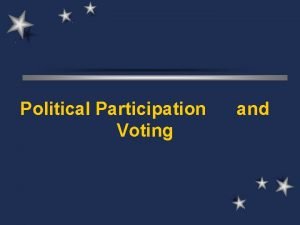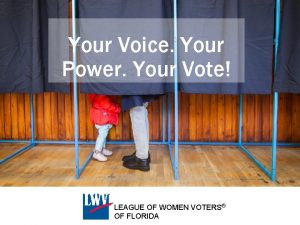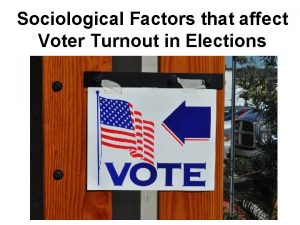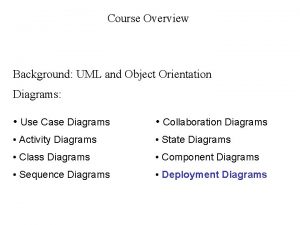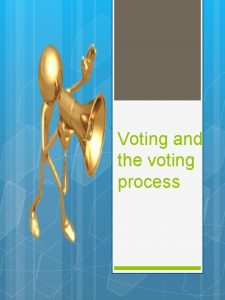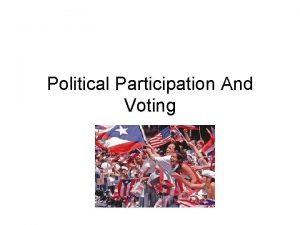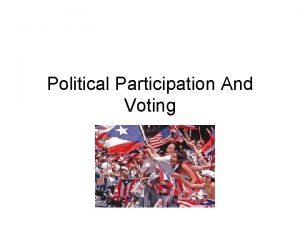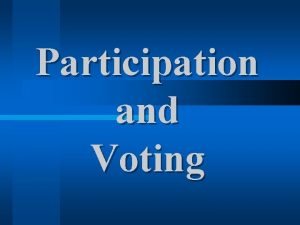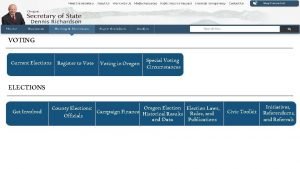Political Participation and Voting Forms of Political Participation














- Slides: 14

Political Participation and Voting

Forms of Political Participation Traditional political participation: various activities designed to influence government. – Voting, protest, campaign contributions, contact elected officials, wearing a campaign button, volunteering at a campaign office Online participation: interactive political engagement facilitated by vast opportunities to connect to causes, people, events, and information online.

Forms of Political Participation Benefits of online participation: 1. Access to information 2. Accidental mobilization 3. Format advantages – Images, interaction, and unlimited space 4. Diversity of sources and voices 5. Lowers entry barriers 6. Citizen journalism: blogs, video, social media

Political Participation

Voting Suffrage extended to different groups at different points in American history. Initially only wealthy (propertyowning) white men 21 and older. – Wealth limitation eliminated early 1800 s – 15 th Amendment enfranchises black men (1870) – 19 th Amendment enfranchises women (1920) – 24 th Amendment ends poll taxes (1964) – 26 th Amendment lowers age to 18 (1971)

Voting • Right to vote: all American citizens >18 yrs. old – 10 states allow for a lifetime voting bans for convicted felons (a clemency hearing decides voter rights individually) • Turnout relatively low today – Lower than other democracies, points in American history – 60% national average presidential elections – 33% national average off-year national races • Significant state and regional differences

Voting Voter turnout in democratic nations 1945– 2008

Voting

Voting

Voting Why do people vote? • Individual preferences and traits – Partisanship, ideology, religion, sex, income, etc. • Political environment – Campaigns, issues, mobilization, party competition • State policies – Registration deadlines and methods, identification, ballot types (paper, mail only, etc. )

Voting Individual traits and preferences • Demographic indicators – Education, income, sex, race/ethnicity, age – Education: highest impact because influences so many other factors correlated with voter turnout information, efficacy, income • Preferences and attitudes – Party attachment, ideology, issue positions • Makes sense: people with well-formed opinions vote

Voting Political environment • Context can attract voters to the polls – Candidates, pressing issues (is it a time of crisis? War? ) – Mobilization strategies and investment – Party competition (or lack thereof) • Consistently competitive or noncompetitive – Voters, candidates, parties and contributors ALL take party competition into account. – Candidates want heated competition, but don’t want it to turn so negative that voters stay home

Voting State policies • All states implement voting and election laws differently. Some make it easier than others. – – – Registration deadlines prior to election day Length of residency at current address Identification requirements (controversy of voter ID laws) Early and absentee voting rules Variable vote locations Ballot method: mail only, paper ballot, kiosk, etc.

American Voters Why is turnout different across groups? Turnout = state rules + political context + individual traits • Variation in all three areas explains voter turnout trends.
 Contoh partial participation
Contoh partial participation Milbrath
Milbrath Gladiatorial political participation
Gladiatorial political participation Pros and cons of fptp
Pros and cons of fptp Affirmative long and short forms
Affirmative long and short forms Strong and weak forms of auxiliary verbs
Strong and weak forms of auxiliary verbs Imf voting power
Imf voting power Compulsory voting essay
Compulsory voting essay Voting rights
Voting rights Voting by feet tiebout
Voting by feet tiebout Hough voting
Hough voting A student who lives in minneapolis chooses to spend
A student who lives in minneapolis chooses to spend Sociological factors that affect voting behavior
Sociological factors that affect voting behavior Deployment diagram for online voting system
Deployment diagram for online voting system Block diagram of mobile phone
Block diagram of mobile phone


